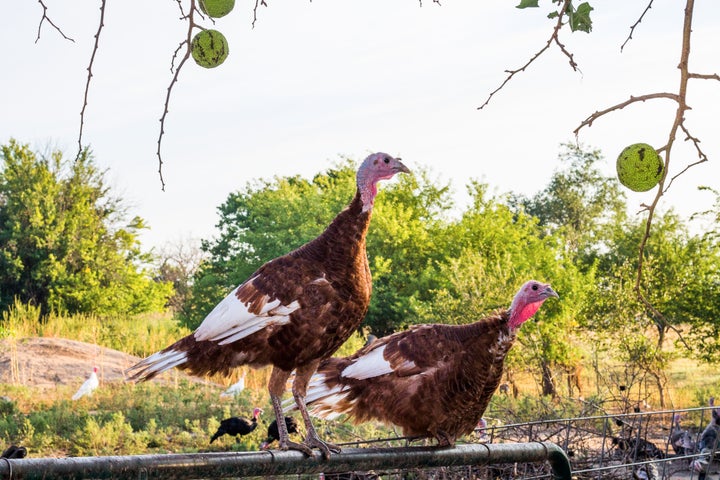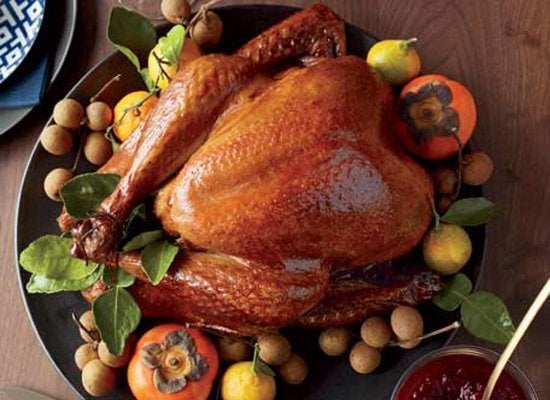Everything Thanksgiving: Get all our Thanksgiving recipes, how-to’s and more!
In the not-too-distant past, all Thanksgiving turkeys came from the grocery store. Give or take a few pounds, they were identically pallid and big-breasted birds ― classic Butterball-type turkeys. These hybrids were bred to fatten quickly on formulated feed in climate-controlled barns. In about 12 weeks, they grew from freshly hatched poults to 24-plus-pound hens, ready for slaughter.
These turkeys cooked ― and tasted ― pretty much the same from year to year.
But what makes a turkey a turkey is no longer so generic.
Perhaps you’re one of the many people who has made the switch with a pasture-raised or a heritage bird for your holiday table. You may know all about the animal welfare benefits that result in a more nutritious turkey. But what most people don’t know is how these birds of a different feather perform in the kitchen.
It’s a lesson I learned the hard way my first Thanksgiving with a house full of guests and a pasture-raised bird cooked on my Traeger grill. The turkey turned out Instagrammably browned and the digital thermometer registered 165 degrees. But when I slid my knife between the thigh to start carving, I saw that the meat was still vividly, inedibly pink.
What was it about this turkey that made cooking it so different from conventional turkey? I started asking around and learned that there is more variability to cooking turkeys raised on pasture: The breasts cook quicker while the thigh meat takes longer. Here’s why.
Know Your Turkey
First of all, it’s important to recognize that a pasture-raised turkey is not necessarily a heritage turkey. Any turkey raised outdoors can be called pasture-raised. (Also called free-range, this term is not regulated by the U.S. Department of Agriculture, and shoppers should look for third-party animal welfare certifications.)
Although turkeys raised on pasture are often slower-growing hybrids than industrial turkeys, their genes still bestow them with stubby legs, weak joints and oversized breasts that prevent them from flying, roosting or mating. But free to move outdoors, they have space to flap their wings, wobble around and forage.
The distinctions are even more marked with heritage turkeys. Bred from rare genetic poultry lines to express their natural behaviors, including running, flying, roosting and even mating, they have tapered breasts and strong legs. Officially called standard bred turkeys, these are the much-touted Bronze, Bourbon Red and Narrangansett turkeys. But other turkey breeds, like Chocolate and Jersey Buff, that are not formally recognized by the American Poultry Association, are also called heritage.
One of the first experts I consulted was Frank Reese, the foremost heritage poultry breeder in the country. He raises about 5,000 Thanksgiving turkeys each year on Good Shepherd Poultry Ranch in Lindsborg, Kansas. “It takes twice as long for me to grow these turkeys,” he said. “There’s a huge difference in how the carcass looks.”
Most striking is the breast, which is slender and hugs the prominent keel bone. The wings and the legs are longer too, and the muscles are well exercised. Both the white and the dark meat have more color, too. This is the result of oxygenation, Reese explained. “The whiter the meat, the poorer the muscle mass.”

Pasture-raised poultry ― even from faster-growing breeds ― has more muscle tone, whereas birds raised in confinement are flabby with limp joints and weak bones. Well-exercised muscles, as any good butcher will tell you, are the most flavorful. And this meat takes longer to cook.
Reese didn’t have a positive word to say about the white broad-breasted turkey ― even those raised on pasture. But he helped me to understand how living conditions and muscle composition were the reasons my turkey remained pink.
How To Cook It
Clearly, this is not the average turkey that you pop into a 350-degree oven to roast for 15 to 20 minutes per pound while you turn your attention to the Thanksgiving sides. So, how do you properly roast a turkey that didn’t come from a factory farm?
Heritage Foods USA is the principle purveyor for Reese’s turkeys. One of their key tips is that there is no standardized timing that works for every bird. Cooking times depend on the size of the turkey, the roasting temperature, whether the turkey is stuffed and the idiosyncrasies of your oven.
Western Daughters Butcher Shoppe CEO Kate Kavanaugh, who has nearly 10 years experience cooking heritage turkeys, doesn’t like to give instructions for minutes per pound. “In general, we have found that heritage birds run 8 to 12 minutes per pound,” she said. But that’s just a guideline. The key is to trust your thermometer, and to check the temperature in both the breast and the thigh meat to gauge doneness.
When it comes to cooking temperatures, Indiana farmer Greg Gunthorp, who sells his pasture-raised turkeys to Rick Bayless and Chicago Mayor Rahm Emmanuel, among others, recommends low and slow for best results whether in the oven or a Big Green Egg. Heritage Foods USA stipulates 325-degree oven temperature to allow the fats to render, yielding white meat that is both tender and juicy. But prepare yourself for pigmented meat, especially close to the bone.
Josh Rathbun, executive chef of Siena Tuscan Steakhouse in Wichita, Kansas, also firmly endorses the low-and-slow approach.“If you can slow it down ― and maybe even throw some foil on the breast ― and rock slow heat for a while, you’ll give the meat time to break down,” he told HuffPost. He suggested cooking your heritage turkey at 325 degrees or below, and also recommended turning up the heat to 400 or 425 degrees at the end to crisp the skin.
To avoid the problem of overcooking the breast meat at any temperature, many experts recommend separating the thigh and leg meat.
That’s exactly how I resolved my dilemma of undercooked meat. I separated the thighs and legs, and after the breast meat finished cooking and rested under foil, I continued to roast the legs and thighs to 175 degrees, until the juices ran clear, for over an hour.
Once the meat was carved onto a platter, no one was the wiser that Thanksgiving ― except for me.
I learned that that variability is the nature of these farm-raised turkeys. The unique composition of their proteins and fats, their age and activity, and their ability to forage for a varied diet all create more flavor. And for that I am grateful.
